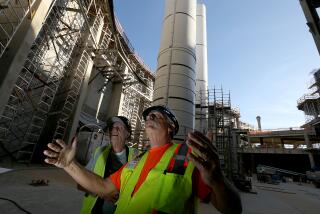Shuttle Rocket O-Ring Seals Not Damaged
- Share via
KENNEDY SPACE CENTER, Fla. — The O-ring seals in the joints of the space shuttle Discovery’s booster rockets suffered no damage during last month’s launch, NASA reported Monday.
The shuttle Challenger was destroyed and its crew of seven lost on Jan. 28, 1986, when super-hot gas and flames burned through the synthetic rubber O-rings in a faulty joint in one of its boosters.
Discovery’s Sept. 28 launch was the first since the accident, and its two solid fuel rockets burned for two minutes as planned and then parachuted into the Atlantic Ocean, where they were recovered and returned to Kennedy Space Center for inspection.
Excellent Condition
Officials reported earlier that an initial inspection after recovery indicated the rockets were in excellent condition.
Ed Medal, a spokesman for the National Aeronautics and Space Administration’s Marshall Space Flight Center in Huntsville, Ala., reported late Monday that engineers had completed dismantling both booster rockets.
“All six field joints were taken apart and looked at,” he said. “Everything looks great. There was no evidence of hot gas or heat on any of the O-rings. The new bonded installation did its job.”
There are three joints in each of the 149-foot-tall rockets. Each joint has three O-rings.
“There is no evidence of any gas pressure on any of the O-rings, including the new ‘capture feature’ O-ring,” Medal said. “They really look good.”
He said new insulation added to the joint area also worked as intended in keeping burning gases away from the rings.
Prevent Joint Movement
On Challenger, each joint had two O-rings. In redesigning the rocket, engineers at the Marshall center and at Morton Thiokol, the manufacturer, added a third O-ring as part of a metal lip, called a capture feature, intended to prevent joint movement under pressure of ignition.
Discovery and its five-man crew landed at Edwards Air Force Base in California on Oct. 3 after a four-day flight during which the astronauts deployed a communications satellite, conducted experiments and tested new orbiter systems.
The shuttle was ferried back to Cape Canaveral on Saturday, riding piggyback atop a modified Boeing 747 jetliner. It was back at its launch site Monday, being inspected in a processing facility.
More to Read
Sign up for Essential California
The most important California stories and recommendations in your inbox every morning.
You may occasionally receive promotional content from the Los Angeles Times.













